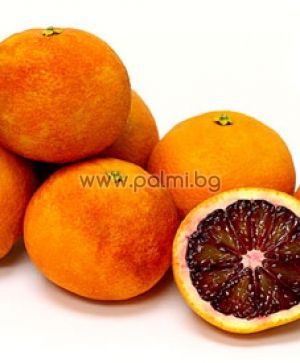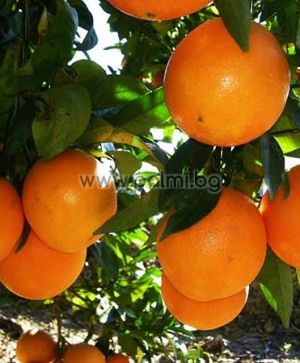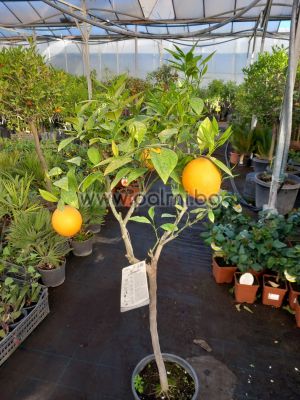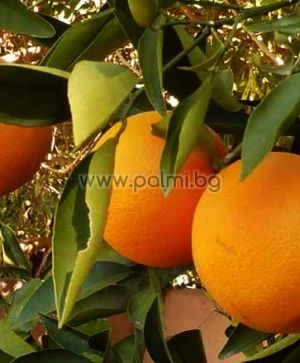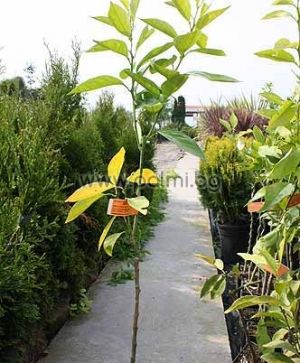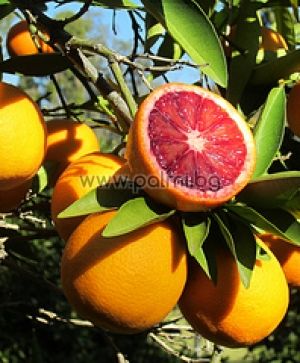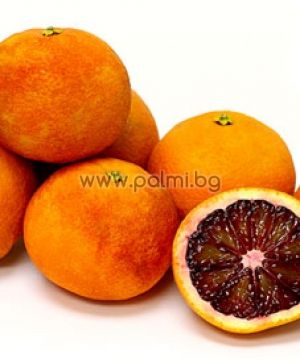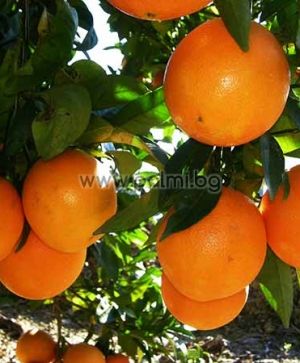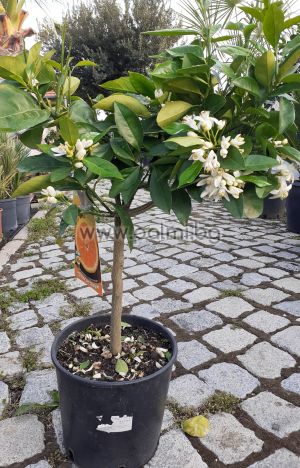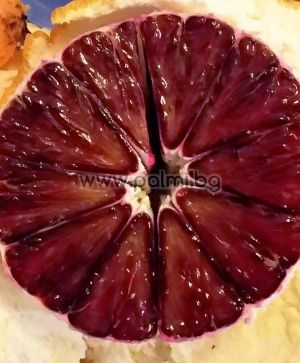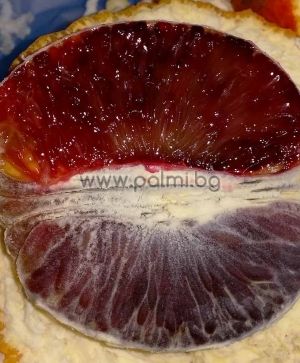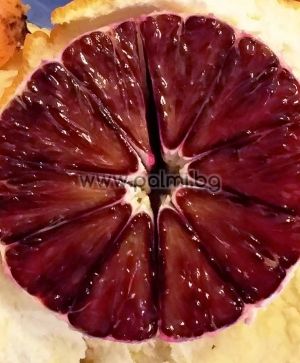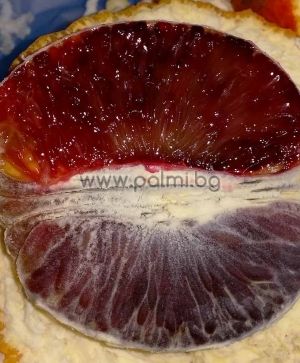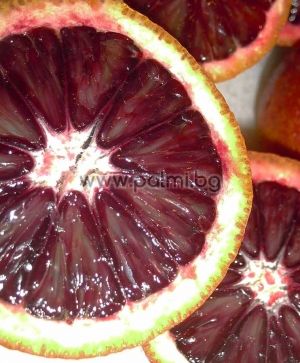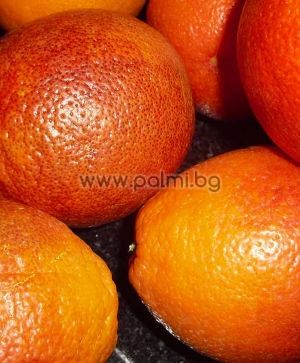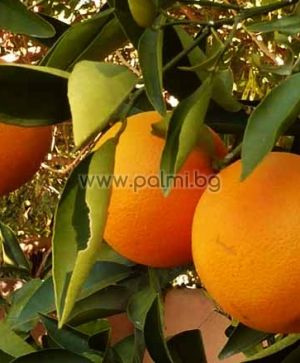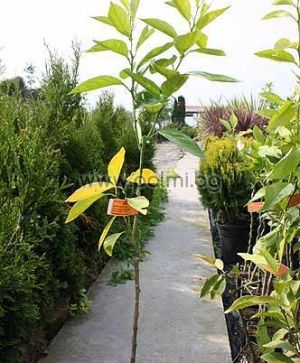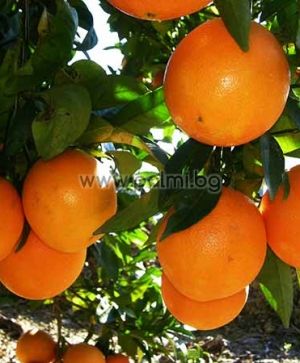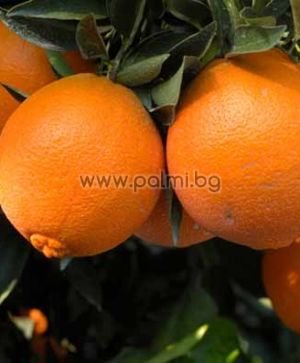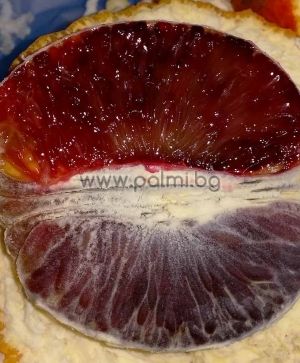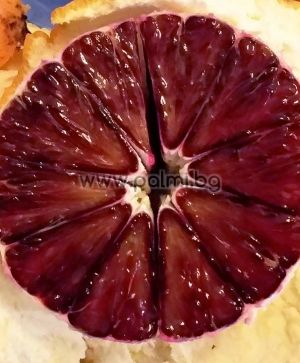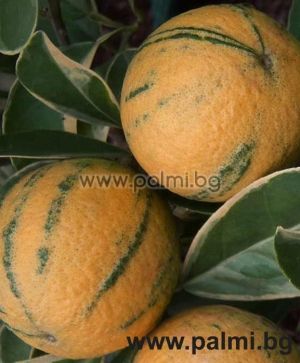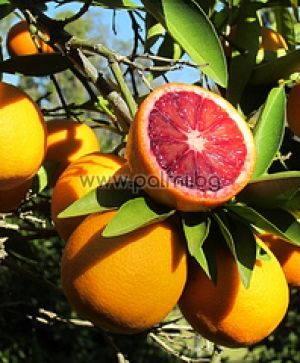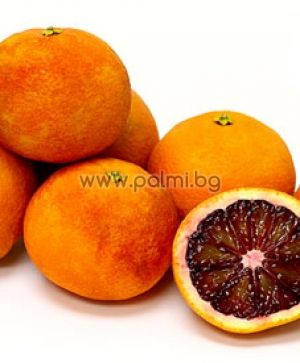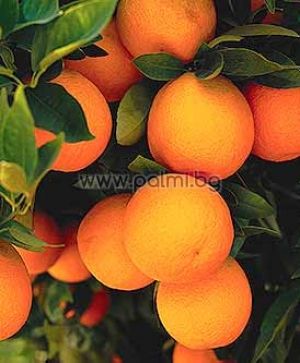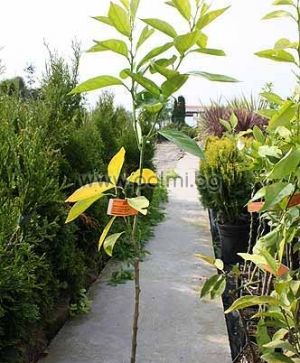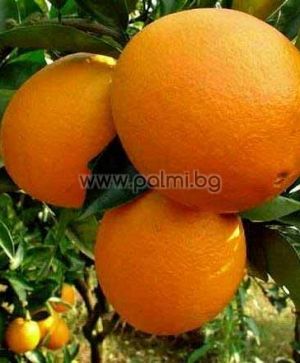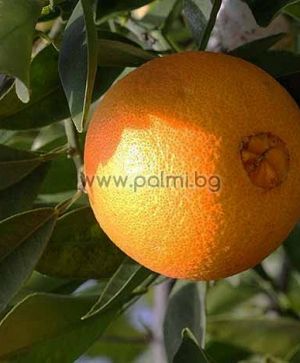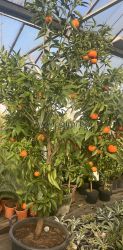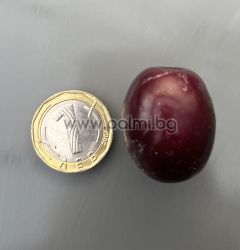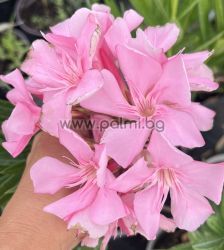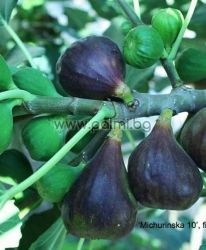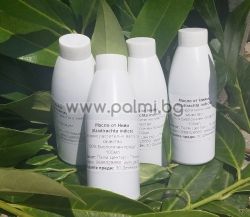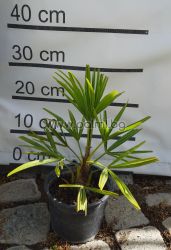Products
Blood Orange Moro
Important notice! Most citrus plants on the market are produced for planting in orchards in the Mediterranean countries. They have a large overall height, have high graft and are difficult to shape and support at home. Rootstocks on which they are grafted are very fast growing, which is fine for the open ground in the subtropics, but is not desirable when growing in pot in the temperate climate.
All our small citrus plants are produced specifically for the Bulgarian market and are ideally suited for home cultivation. The rootstocks cause compact growth, grafts are low and this allows making an excellent shape of the crown, to be suitable for growing in pots. The used rootstocks are trifoliate orange (Poncirus trifoliata 'Flying Dragon') and Volkamer lemon, Citrus volkameriana. Trifoliate orange is frost-hardy to -25°C, and significantly increases the cold resistance of plants grafted on it.
Citrus sinensis Moro, Orange from Botanical Garden - Plovdiv, Bulgaria
The Red Orange, or Blood orange, first appeared on the island of Sicily. It was believed that the red color of meat and unique taste are due to the unique climate in Sicily and the volcanic soils. The fruits ripen from February to April.
Today mainly several varieties are growing, and are already found in other parts of Italy as well as Greece and Spain .
As with all other Citrus plants, the orange is susceptible to scales and spider mites and needs to be sprayed twice a year.
In winter it will need a cool place with temperatures 0-10 degrees Celsius. If the temperature is higher, the leaves usually fall off. In summer it needs to be outside and abundantly watered.
Much more information about all citrus species is available on our forum:
Availability: 7 pcs
Orange Arancio
Important notice! Most citrus plants on the market are produced for planting in orchards in the Mediterranean countries. They have a large overall height, have high graft and are difficult to shape and support at home. Rootstocks on which they are grafted are very fast growing, which is fine for the open ground in the subtropics, but is not desirable when growing in pot in the temperate climate.
All our small citrus plants are produced specifically for the Bulgarian market and are ideally suited for home cultivation. The rootstocks cause compact growth, grafts are low and this allows making an excellent shape of the crown, to be suitable for growing in pots. The used rootstocks are trifoliate orange (Poncirus trifoliata 'Flying Dragon') and Volkamer lemon, Citrus volkameriana. Trifoliate orange is frost-hardy to -25°C, and significantly increases the cold resistance of plants grafted on it.
Citrus sinensis Arancio, Orange from Botanical Garden - Plovdiv, Bulgaria
If the temperature is higher, the leaves usually fall off. In summer it needs to be outside and abundantly watered.
Much more information about all citrus species is available on our forum:
Availability: 2 pcs
Orange Cara Cara Flying Dragon
Important notice! Most citrus plants on the market are produced for planting in orchards in the Mediterranean countries. They have a large overall height, have high graft and are difficult to shape and support at home. Rootstocks on which they are grafted are very fast growing, which is fine for the open ground in the subtropics, but is not desirable when growing in pot in the temperate climate.
All our small citrus plants are produced specifically for the Bulgarian market and are ideally suited for home cultivation. The rootstocks cause compact growth, grafts are low and this allows making an excellent shape of the crown, to be suitable for growing in pots. The used rootstocks are trifoliate orange (Poncirus trifoliata 'Flying Dragon') and Volkamer lemon, Citrus volkameriana. Trifoliate orange is frost-hardy to -25°C, and significantly increases the cold resistance of plants grafted on it.
Citrus sinensis Cara Cara, Orange on FLYING DRAGON
from Botanical Garden - Plovdiv, Bulgaria
As with all other Citrus plants, the orange is susceptible to scales and spider mites and needs to be sprayed twice a year.
In winter it will need a cool place with temperatures 0-10 degrees Celsius. If the temperature is higher, the leaves usually fall off. In summer it needs to be outside and abundantly watered.
Much more information about all citrus species is available on our forum:
Availability: 12 pcs
Blood Orange Moro Fkying Dragon
Important notice! Most citrus plants on the market are produced for planting in orchards in the Mediterranean countries. They have a large overall height, have high graft and are difficult to shape and support at home. Rootstocks on which they are grafted are very fast growing, which is fine for the open ground in the subtropics, but is not desirable when growing in pot in the temperate climate.
All our small citrus plants are produced specifically for the Bulgarian market and are ideally suited for home cultivation. The rootstocks cause compact growth, grafts are low and this allows making an excellent shape of the crown, to be suitable for growing in pots. The used rootstocks are trifoliate orange (Poncirus trifoliata 'Flying Dragon') and Volkamer lemon, Citrus volkameriana. Trifoliate orange is frost-hardy to -25°C, and significantly increases the cold resistance of plants grafted on it.
Citrus sinensis Moro, Orange from Botanical Garden - Plovdiv, Bulgaria
The Red Orange, or Blood orange, first appeared on the island of Sicily. It was believed that the red color of meat and unique taste are due to the unique climate in Sicily and the volcanic soils. The fruits ripen from February to April.
Today mainly several varieties are growing, and are already found in other parts of Italy as well as Greece and Spain .
As with all other Citrus plants, the orange is susceptible to scales and spider mites and needs to be sprayed twice a year.
In winter it will need a cool place with temperatures 0-10 degrees Celsius. If the temperature is higher, the leaves usually fall off. In summer it needs to be outside and abundantly watered.
Much more information about all citrus species is available on our forum:
Availability: 1 pcs
Orange Arancio
Important notice! Most citrus plants on the market are produced for planting in orchards in the Mediterranean countries. They have a large overall height, have high graft and are difficult to shape and support at home. Rootstocks on which they are grafted are very fast growing, which is fine for the open ground in the subtropics, but is not desirable when growing in pot in the temperate climate.
All our small citrus plants are produced specifically for the Bulgarian market and are ideally suited for home cultivation. The rootstocks cause compact growth, grafts are low and this allows making an excellent shape of the crown, to be suitable for growing in pots. The used rootstocks are trifoliate orange (Poncirus trifoliata 'Flying Dragon') and Volkamer lemon, Citrus volkameriana. Trifoliate orange is frost-hardy to -25°C, and significantly increases the cold resistance of plants grafted on it.
Citrus sinensis Arancio, Orange from Botanical Garden - Plovdiv, Bulgaria
If the temperature is higher, the leaves usually fall off. In summer it needs to be outside and abundantly watered.
Much more information about all citrus species is available on our forum:
Availability: 18 pcs
Blood Orange, 'Taroco Meli' on Flyng Dragon rootstock
Important notice! Most citrus plants on the market are produced for planting in orchards in the Mediterranean countries. They have a large overall height, have high graft and are difficult to shape and support at home. Rootstocks on which they are grafted are very fast growing, which is fine for the open ground in the subtropics, but is not desirable when growing in pot in the temperate climate.
All our small citrus plants are produced specifically for the Bulgarian market and are ideally suited for home cultivation. The rootstocks cause compact growth, grafts are low and this allows making an excellent shape of the crown, to be suitable for growing in pots. The used rootstocks are trifoliate orange (Poncirus trifoliata 'Flying Dragon') and Volkamer lemon, Citrus volkameriana. Trifoliate orange is frost-hardy to -25°C, and significantly increases the cold resistance of plants grafted on it.
Citrus sinensis 'Taroco Meli', Blood Orange
from Botanical Garden - Plovdiv, Bulgaria
The Red Orange, or Blood orange, first appeared on the island of Sicily. It was believed that the red color of meat and unique taste are due to the unique climate in Sicily and the volcanic soils. The fruits ripen from February to April.
Today mainly several varieties are growing, and are already found in other parts of Italy as well as Greece and Spain .
As with all other Citrus plants, the orange is susceptible to scales and spider mites and needs to be sprayed twice a year.
In winter it will need a cool place with temperatures 0-10 degrees Celsius. If the temperature is higher, the leaves usually fall off. In summer it needs to be outside and abundantly watered.
Much more information about all citrus species is available on our forum:
Availability: 1 pcs
Blood Orange, Taroco Scirè V.C.R on Flyng Dragon rootstock
Important notice! Most citrus plants on the market are produced for planting in orchards in the Mediterranean countries. They have a large overall height, have high graft and are difficult to shape and support at home. Rootstocks on which they are grafted are very fast growing, which is fine for the open ground in the subtropics, but is not desirable when growing in pot in the temperate climate.
All our small citrus plants are produced specifically for the Bulgarian market and are ideally suited for home cultivation. The rootstocks cause compact growth, grafts are low and this allows making an excellent shape of the crown, to be suitable for growing in pots. The used rootstocks are trifoliate orange (Poncirus trifoliata 'Flying Dragon') and Volkamer lemon, Citrus volkameriana. Trifoliate orange is frost-hardy to -25°C, and significantly increases the cold resistance of plants grafted on it.
Citrus sinensis Taroco Scirè V.C.R, Blood Orange
from Botanical Garden - Plovdiv, Bulgaria
The Red Orange, or Blood orange, first appeared on the island of Sicily. It was believed that the red color of meat and unique taste are due to the unique climate in Sicily and the volcanic soils. The fruits ripen from February to April.
Today mainly several varieties are growing, and are already found in other parts of Italy as well as Greece and Spain .
As with all other Citrus plants, the orange is susceptible to scales and spider mites and needs to be sprayed twice a year.
In winter it will need a cool place with temperatures 0-10 degrees Celsius. If the temperature is higher, the leaves usually fall off. In summer it needs to be outside and abundantly watered.
Much more information about all citrus species is available on our forum:
Availability: 1 pcs
Blood Orange Sanguinello SSA Nuc. 66-SSA-12
Important notice! Most citrus plants on the market are produced for planting in orchards in the Mediterranean countries. They have a large overall height, have high graft and are difficult to shape and support at home. Rootstocks on which they are grafted are very fast growing, which is fine for the open ground in the subtropics, but is not desirable when growing in pot in the temperate climate.
All our small citrus plants are produced specifically for the Bulgarian market and are ideally suited for home cultivation. The rootstocks cause compact growth, grafts are low and this allows making an excellent shape of the crown, to be suitable for growing in pots. The used rootstocks are trifoliate orange (Poncirus trifoliata 'Flying Dragon') and Volkamer lemon, Citrus volkameriana. Trifoliate orange is frost-hardy to -25°C, and significantly increases the cold resistance of plants grafted on it.
Citrus sinensis 'Sanguinello', Blood Orange from Botanical Garden - Plovdiv, Bulgaria
The Red Orange, or Blood orange, first appeared on the island of Sicily. It was believed that the red color of meat and unique taste are due to the unique climate in Sicily and the volcanic soils. The fruits ripen from February to April.
Today mainly several varieties are growing, and are already found in other parts of Italy as well as Greece and Spain .
As with all other Citrus plants, the orange is susceptible to scales and spider mites and needs to be sprayed twice a year.
In winter it will need a cool place with temperatures 0-10 degrees Celsius. If the temperature is higher, the leaves usually fall off. In summer it needs to be outside and abundantly watered.
Much more information about all citrus species is available on our forum:
Availability: 7 pcs
Orange Cara Cara
Important notice! Most citrus plants on the market are produced for planting in orchards in the Mediterranean countries. They have a large overall height, have high graft and are difficult to shape and support at home. Rootstocks on which they are grafted are very fast growing, which is fine for the open ground in the subtropics, but is not desirable when growing in pot in the temperate climate.
All our small citrus plants are produced specifically for the Bulgarian market and are ideally suited for home cultivation. The rootstocks cause compact growth, grafts are low and this allows making an excellent shape of the crown, to be suitable for growing in pots. The used rootstocks are trifoliate orange (Poncirus trifoliata 'Flying Dragon') and Volkamer lemon, Citrus volkameriana. Trifoliate orange is frost-hardy to -25°C, and significantly increases the cold resistance of plants grafted on it.
Citrus sinensis Cara Cara, Orange
from Botanical Garden - Plovdiv, Bulgaria
As with all other Citrus plants, the orange is susceptible to scales and spider mites and needs to be sprayed twice a year.
In winter it will need a cool place with temperatures 0-10 degrees Celsius. If the temperature is higher, the leaves usually fall off. In summer it needs to be outside and abundantly watered.
Much more information about all citrus species is available on our forum:
Availability: 7 pcs
Orange 'Newhall V.C.R.'
Important notice! Most citrus plants on the market are produced for planting in orchards in the Mediterranean countries. They have a large overall height, have high graft and are difficult to shape and support at home. Rootstocks on which they are grafted are very fast growing, which is fine for the open ground in the subtropics, but is not desirable when growing in pot in the temperate climate.
All our small citrus plants are produced specifically for the Bulgarian market and are ideally suited for home cultivation. The rootstocks cause compact growth, grafts are low and this allows making an excellent shape of the crown, to be suitable for growing in pots. The used rootstocks are trifoliate orange (Poncirus trifoliata 'Flying Dragon') and Volkamer lemon, Citrus volkameriana. Trifoliate orange is frost-hardy to -25°C, and significantly increases the cold resistance of plants grafted on it.
Citrus sinensis 'Newhall V.C.R.', Orange
from Botanical Garden - Plovdiv, Bulgaria
These Navel oranges ripen in December-January. The fruits are very sweet, juicy and seedless.
As with all other Citrus plants, the orange is susceptible to scales and spider mites and needs to be sprayed twice a year.
In winter it will need a cool place with temperatures 0-10 degrees Celsius. If the temperature is higher, the leaves usually fall off. In summer it needs to be outside and abundantly watered.
Much more information about all citrus species is available on our forum:
Availability: 3 pcs
Blood Orange, 'Taroco Meli'
Important notice! Most citrus plants on the market are produced for planting in orchards in the Mediterranean countries. They have a large overall height, have high graft and are difficult to shape and support at home. Rootstocks on which they are grafted are very fast growing, which is fine for the open ground in the subtropics, but is not desirable when growing in pot in the temperate climate.
All our small citrus plants are produced specifically for the Bulgarian market and are ideally suited for home cultivation. The rootstocks cause compact growth, grafts are low and this allows making an excellent shape of the crown, to be suitable for growing in pots. The used rootstocks are trifoliate orange (Poncirus trifoliata 'Flying Dragon') and Volkamer lemon, Citrus volkameriana. Trifoliate orange is frost-hardy to -25°C, and significantly increases the cold resistance of plants grafted on it.
Citrus sinensis 'Taroco Meli', Blood Orange
from Botanical Garden - Plovdiv, Bulgaria
The Red Orange, or Blood orange, first appeared on the island of Sicily. It was believed that the red color of meat and unique taste are due to the unique climate in Sicily and the volcanic soils. The fruits ripen from February to April.
Today mainly several varieties are growing, and are already found in other parts of Italy as well as Greece and Spain .
As with all other Citrus plants, the orange is susceptible to scales and spider mites and needs to be sprayed twice a year.
In winter it will need a cool place with temperatures 0-10 degrees Celsius. If the temperature is higher, the leaves usually fall off. In summer it needs to be outside and abundantly watered.
Much more information about all citrus species is available on our forum:
Availability: 7 pcs
Blood Orange, Taroco Scirè V.C.R
Important notice! Most citrus plants on the market are produced for planting in orchards in the Mediterranean countries. They have a large overall height, have high graft and are difficult to shape and support at home. Rootstocks on which they are grafted are very fast growing, which is fine for the open ground in the subtropics, but is not desirable when growing in pot in the temperate climate.
All our small citrus plants are produced specifically for the Bulgarian market and are ideally suited for home cultivation. The rootstocks cause compact growth, grafts are low and this allows making an excellent shape of the crown, to be suitable for growing in pots. The used rootstocks are trifoliate orange (Poncirus trifoliata 'Flying Dragon') and Volkamer lemon, Citrus volkameriana. Trifoliate orange is frost-hardy to -25°C, and significantly increases the cold resistance of plants grafted on it.
Citrus sinensis Taroco Scirè V.C.R, Blood Orange
from Botanical Garden - Plovdiv, Bulgaria
The Red Orange, or Blood orange, first appeared on the island of Sicily. It was believed that the red color of meat and unique taste are due to the unique climate in Sicily and the volcanic soils. The fruits ripen from February to April.
Today mainly several varieties are growing, and are already found in other parts of Italy as well as Greece and Spain .
As with all other Citrus plants, the orange is susceptible to scales and spider mites and needs to be sprayed twice a year.
In winter it will need a cool place with temperatures 0-10 degrees Celsius. If the temperature is higher, the leaves usually fall off. In summer it needs to be outside and abundantly watered.
Much more information about all citrus species is available on our forum:
Availability: 2 pcs
Variegated Orange
Important notice! Most citrus plants on the market are produced for planting in orchards in the Mediterranean countries. They have a large overall height, have high graft and are difficult to shape and support at home. Rootstocks on which they are grafted are very fast growing, which is fine for the open ground in the subtropics, but is not desirable when growing in pot in the temperate climate.
All our small citrus plants are produced specifically for the Bulgarian market and are ideally suited for home cultivation. The rootstocks cause compact growth, grafts are low and this allows making an excellent shape of the crown, to be suitable for growing in pots. The used rootstocks are trifoliate orange (Poncirus trifoliata 'Flying Dragon') and Volkamer lemon, Citrus volkameriana. Trifoliate orange is frost-hardy to -25°C, and significantly increases the cold resistance of plants grafted on it.
Citrus sinensis variegata,
Variegated Orange from Botanical Garden - Plovdiv, Bulgaria
In winter it will need a cool place with temperatures 0-10 degrees Celsius. If the temperature is higher, the leaves usually fall off. In summer it needs to be outside and abundantly watered.
Much more information about all citrus species is available on our forum:
Availability: 5 pcs
Blood Orange Moro
Important notice! Most citrus plants on the market are produced for planting in orchards in the Mediterranean countries. They have a large overall height, have high graft and are difficult to shape and support at home. Rootstocks on which they are grafted are very fast growing, which is fine for the open ground in the subtropics, but is not desirable when growing in pot in the temperate climate.
All our small citrus plants are produced specifically for the Bulgarian market and are ideally suited for home cultivation. The rootstocks cause compact growth, grafts are low and this allows making an excellent shape of the crown, to be suitable for growing in pots. The used rootstocks are trifoliate orange (Poncirus trifoliata 'Flying Dragon') and Volkamer lemon, Citrus volkameriana. Trifoliate orange is frost-hardy to -25°C, and significantly increases the cold resistance of plants grafted on it.
Citrus sinensis Moro, Orange from Botanical Garden - Plovdiv, Bulgaria
The Red Orange, or Blood orange, first appeared on the island of Sicily. It was believed that the red color of meat and unique taste are due to the unique climate in Sicily and the volcanic soils. The fruits ripen from February to April.
Today mainly several varieties are growing, and are already found in other parts of Italy as well as Greece and Spain .
As with all other Citrus plants, the orange is susceptible to scales and spider mites and needs to be sprayed twice a year.
In winter it will need a cool place with temperatures 0-10 degrees Celsius. If the temperature is higher, the leaves usually fall off. In summer it needs to be outside and abundantly watered.
Much more information about all citrus species is available on our forum:
Availability: 7 pcs
Valencia Orange
Important notice! Most citrus plants on the market are produced for planting in orchards in the Mediterranean countries. They have a large overall height, have high graft and are difficult to shape and support at home. Rootstocks on which they are grafted are very fast growing, which is fine for the open ground in the subtropics, but is not desirable when growing in pot in the temperate climate.
All our small citrus plants are produced specifically for the Bulgarian market and are ideally suited for home cultivation. The rootstocks cause compact growth, grafts are low and this allows making an excellent shape of the crown, to be suitable for growing in pots. The used rootstocks are trifoliate orange (Poncirus trifoliata 'Flying Dragon') and Volkamer lemon, Citrus volkameriana. Trifoliate orange is frost-hardy to -25°C, and significantly increases the cold resistance of plants grafted on it.
Citrus sinensis Valencia, Orange from Botanical Garden - Plovdiv, Bulgaria
Valencia variety ripens in April and May. This is the most often used variety for fresh or canned juices. The taste of the fruit is slightly sour.
As with all other Citrus plants, the orange is susceptible to scales and spider mites and needs to be sprayed twice a year.
In winter it will need a cool place with temperatures 0-10 degrees Celsius. If the temperature is higher, the leaves usually fall off. In summer it needs to be outside and abundantly watered.
Much more information about all citrus species is available on our forum:
Availability: 21 pcs
Orange Washington Navel
Important notice! Most citrus plants on the market are produced for planting in orchards in the Mediterranean countries. They have a large overall height, have high graft and are difficult to shape and support at home. Rootstocks on which they are grafted are very fast growing, which is fine for the open ground in the subtropics, but is not desirable when growing in pot in the temperate climate.
All our small citrus plants are produced specifically for the Bulgarian market and are ideally suited for home cultivation. The rootstocks cause compact growth, grafts are low and this allows making an excellent shape of the crown, to be suitable for growing in pots. The used rootstocks are trifoliate orange (Poncirus trifoliata 'Flying Dragon') and Volkamer lemon, Citrus volkameriana. Trifoliate orange is frost-hardy to -25°C, and significantly increases the cold resistance of plants grafted on it.
Citrus sinensis Washington Navel, Orange
from Botanical Garden - Plovdiv, Bulgaria
Washington Navel orange ripens in January-February. The fruits are very sweet and juicy and seedless. As with all other Citrus plants, the orange is susceptible to scales and spider mites and needs to be sprayed twice a year.
In winter it will need a cool place with temperatures 0-10 degrees Celsius. If the temperature is higher, the leaves usually fall off. In summer it needs to be outside and abundantly watered.
Much more information about all citrus species is available on our forum:
Availability: 1 pcs



